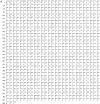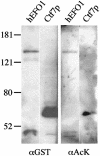Human EFO1p exhibits acetyltransferase activity and is a unique combination of linker histone and Ctf7p/Eco1p chromatid cohesion establishment domains
- PMID: 14576321
- PMCID: PMC275453
- DOI: 10.1093/nar/gkg811
Human EFO1p exhibits acetyltransferase activity and is a unique combination of linker histone and Ctf7p/Eco1p chromatid cohesion establishment domains
Abstract
Proper segregation of chromosomes during mitosis requires that the products of chromosome replication are paired together-termed sister chromatid cohesion. In budding yeast, Ctf7p/Eco1p is an essential protein that establishes cohesion between sister chromatids during S phase. In fission yeast, Eso1p also functions in cohesion establishment, but is comprised of a Ctf7p/Eco1p domain fused to a Rad30p domain (a DNA polymerase) both of which are independently expressed in budding yeast. In this report, we identify and characterize the first candidate human ortholog of Ctf7p/Eco1p, which we term hEFO1p (human Establishment Factor Ortholog). As in fission yeast Eso1p, the hEFO1p open reading frame extends well upstream of the C-terminal Ctf7p/Eco1p domain. However, this N-terminal extension in hEFO1p is unlike Rad30p, but instead exhibits significant homology to linker histone proteins. Thus, hEFO1p is a unique fusion of linker histone and cohesion establishment domains. hEFO1p is widely expressed among the tissues tested. Consistent with a role in chromosome segregation, hEFO1p localizes exclusively to the nucleus when expressed in HeLa tissue culture cells. Moreover, biochemical analyses reveal that hEFO1p exhibits acetyltransferase activity. These findings document the first characterization of a novel human acetyltransferase, hEFO1p, that is comprised of both linker histone and Ctf7p/Eco1p domains.
Figures








References
-
- Skibbens R.V. (2000) Holding your own: establishing sister chromatid cohesion. Genome Res., 10, 1664–1671. - PubMed
-
- Koshland D.E. and Guacci,V. (2000) Sister chromatid cohesion: the beginning of a long and beautiful relationship. Curr. Opin. Cell Biol., 12, 297–301. - PubMed
-
- Nasmyth K., Peters,J.M. and Uhlmann,F. (2000) Splitting the chromosome: cutting the ties that bind sister chromatids. Science, 288, 1379–1385. - PubMed
-
- Michaelis C., Ciosk,R. and Nasmyth,K. (1997) Cohesins: chromosomal proteins that prevent premature separation of sister chromatids. Cell, 91, 35–45. - PubMed
Publication types
MeSH terms
Substances
Associated data
- Actions
Grants and funding
LinkOut - more resources
Full Text Sources
Molecular Biology Databases
Research Materials

